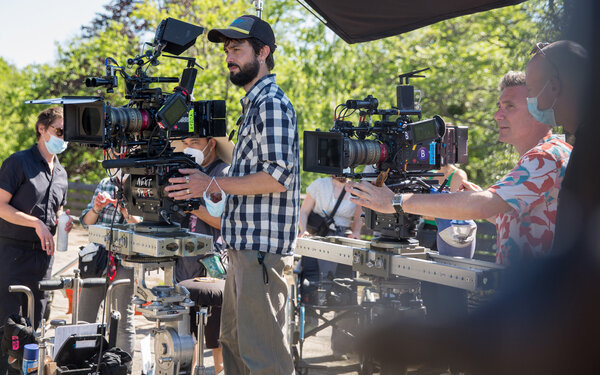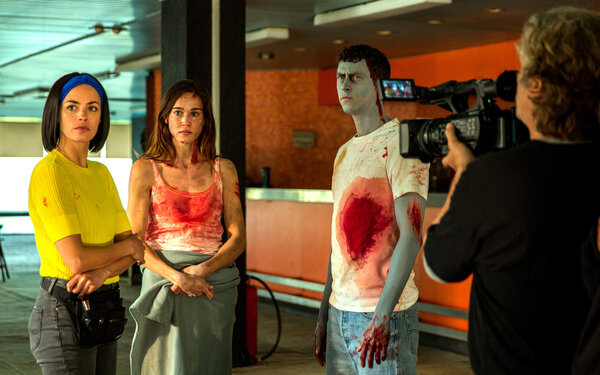Jonathan Ricquebourg, AFC, discusses the challenges of filming "Final Cut", by Michel Hazanavicius
The shooting of a "Z-series" horror film turns into a disaster. The crew is jaded and the actors are absent. Despite a paltry budget, the director seems determined to make this zombie film. However, in the midst of filming, the team is attacked by actual zombies...
What makes for a good remake in your opinion ?
Jonathan Ricquebourg : Above all, it must be another director’s new vision. If we take the example of Scarface, the main character is portrayed radically differently in De Palma’s version compared to the original version by Howard Hawks. Perhaps, however, that remake is so widely adored for superficial reasons. I’m thinking of the 1980’s really flashy side, and some movie scenes from that period have gone down in history. Personally, what I prefer in this remake, is Pacino’s pathetic side, which is really very touching, perhaps more so than in Hawks’ film. It’s a very dark view of America.

On Final Cut, Michel Hazanavicius immediately asked me to watch the Japanese film we were remaking before I even read the script (One Cut of the Dead, by Shin’ichirô Ueda, in 2019). Which I did, studiously ! After having watched the film — not without a certain curiosity – (I think like all viewers) — I then read Michel’s script and then I understood what he wanted to do. Namely : looking at and showing the making of a film – remaking itself ! There was a desire to lead the viewer from one level to another. For example, by retaining the Japanese first names from the outset and attributing them to well-known French actors, it immediately breaks the ambiguity the original film played on. As it plays with all the codes of cinema—one might imagine a set of Russian nesting dolls— this film operates on many levels, and it surpasses its status of a mere “remake” in a certain way. To me, it became a reflection on the very fact of making a remake.
What was chiefly at stake in making this film ?
JR : Firstly, to make people laugh ! And as we know, successful comedies are the ones that have found the right rhythm. Michel paid close attention to the question of rhythm. And rightly so, given an almost entirely storyboarded cut, alongside a screenplay in which each line must fall at the right time. But there was also the visual rhythm, with omnipresent primary colors in the first part, which necessarily imparts a certain tempo on the visuals.
On the shooting side, we knew that there were three separate parts that had to be filmed : the first and the last, with which we necessarily had to start, then the central part, more classic in its form, but where the comedic challenge was also centrally important, since it sets forth what is at stake for each of the characters. As concerns the image, whereas the original film tended to lean towards a desaturated, trashy DV-type image reminiscent of horror found footage, Michel rather desired a more dazzling, pop, catchy image. We began to perform camera tests to find that tone, with the rest of the film in mind, and we did this simultaneously with the month of rehearsals that we were given before starting to shoot this thirty-minute long take.

So, this was a true long take, with no invisible splicing between different takes, as on most films, given the possibility offered by digital cinematography ?
JR : Yes, it’s true long take. It was a really tough scene, with a crazy crew ! First there was the choice of location. An abandoned place, like in the original film, but still different enough to serve the scenography imagined by Michel. This was one of the major concerns in preproduction. Against all odds, this former disused racecourse, which we found in Bondoufle, quickly ticked all the boxes. Essentially a fairly 70’s location, with, for example, splendid blue plastic ceilings, and glass and wood materials that went well with the colors we were aiming for in the long take. It was a very sunny space and had several floors that allowed us to build our very complex scenography. It is also a place with a strong visual identity that nonetheless doesn’t reveal what it actually is. So, we were able to put everything inside it without the film ever being devoured by an overtly inappropriate aesthetic.
How did you shoot this take ?
JR : It took us four days of shooting, with three to four takes a day. All in all, there were fifteen takes and the take in the final cut is one of them. Personally, I had never experienced that on a set. Being able to rehearse for a full month with the entire cast. Michel and I constructed the take as a succession of edited shots... but which were just shot one after the other in continuity. It was a crazy choreography, between the actors who enter and leave the frame sequentially, the special effects, the image and the sound. As to the shooting style, for example, we hesitated for a long time between gimble and shoulder. The former can later be "abused" in postproduction to add a lack of stability or, on the contrary, the second can be stabilized a bit if necessary... As for the camera, we hesitated between an ultra-light configuration using an Alexa Mini with Century 24-70mm zooms, and a Sony Alpha 7 option with Sony 24-70mm photo zooms (with which we had started rehearsals). Finally, because of the zoom effects and changes in camera height, we found that the Ronin really lacked precision in these extreme conditions. We went with the Sony solution, simply replacing the Alpha 7 with an FX6 camera but keeping the autofocus focus tracking function offered internally by the camera. Only a motorized variable DN filter was added so that my assistant could manage the variations in brightness between interior and exterior without modifying the aperture.
Did you shoot the entire take from the shoulder ?
JR : There’s a huge variety of moments in this take, and like I said, each part can almost be seen as a take within the scene. Even if we maintained the shoulder-camera style throughout the thirty minutes, some parts are smoother, or downright impossible to do without using a motorized vehicle. For example, there are parts where I ride a special rickshaw (the race where the camera follows Finnegan and Matilda) that could accommodate me alongside them. Wedged on this rickshaw, the key grip sped along in his rickshaw, following the actors from the side. And then there was also a whole choreography in terms of lighting. A portion of the sources (LEDs) were concealed (behind the plexiglass tiles that can sometimes be seen on the ceiling) and were easily managed from a console. On the other hand, the sparks also had to manage a battery of Dinolights and move them during the take to allow the camera to pass. This tungsten light, corrected with a half CTB, allowed me to keep some warmth on the faces in this red and blue interior. My initial idea was also to ensure a certain connection between the indoor takes, despite the variations in daylight, in case several takes needed to be used in the final cut.
It’s a very sunny atmosphere, very bright...
JR : We shot between April and May 2021, and this is definitely the worst month for continuity between outdoor takes. The weather was highly variable, and green is literally exploding in nature. We really embraced it on screen and didn’t try to tone it down during color grading. We liked the exploding colors, which take the opposite tack of a cold, dirty, gloomy horror film !

Let’s move on to the central part of the film... you must have been a little bored after such a challenge ?
JR : In a way, I was quite happy to stop the long takes as they require a lot of physical camera work, and to return to a more "normal" work tempo. For example, returning to making shot reverse shot scenes, especially with a cast like that ! The main challenge of this part was above all to develop the comic aspect begun in the opening long take. So, we went about these scenes with a kind of jubilation from what we’d just achieved, and a very strong team spirit coming out of the four weeks of rehearsals. In terms of image, Michel wanted a clean break with the aperture, and thought we might opt f for shooting the film in 35mm. But, to perfect the comic effect, we necessarily had to shoot a lot of takes and that quickly became prohibitive in 35mm. The other parameter was the locations in which we were going to be shooting, and especially the meeting rooms and offices which Michael didn’t much care for. He wanted to respect these locations, and we had the idea of moving towards the Alexa LF’s full frame precisely in order to make the settings somewhat less present on screen. In terms of lenses, tests were carried out. The choice was between a Gecko series from GL Optics (similar to the vintage look of the K35s) and the Thalia series from Leitz. Finally, Michel chose the Thalia, for their more “photographic” rendering, with undoubtedly greater realism, and a sharper image. His desire for a perhaps somewhat less glamorous image in this part of the film, seemed important to him. Realism and sobriety, whether on camera, in make-up or in costumes — that was really his credo for this part of the film. The protagonists’ apartment, for example, was chosen with exactly this in mind. As for the choice of focal lengths, this part was very often shot at 55mm in full frame, which corresponds to 40 in Super 35. This choice sometimes forced me to alternate between two cameras on some scenes : the 55 Thalia with an Angénieux zoom lens (the 55mm Thalia is rare on the market in France). This is a focal length that maintains the lines well, without any short focal length effect, and produces a very graphic and very draughtsmanlike image. Compared to the opening long take (the one mounted in the final cut was shot in the sun), I also wanted to offer a colder image, while maintaining good contrast, contrary, once again, to what is imposed by traditional comedy film visual codes.
The visual transition is still pretty severe, no ?
JR : Yes, it’s a bit of a shock. That’s why I lit certain sets quite a bit, such as the sets of offices used for preparation, so that daylight enters the image using 18kWs. It was, in my opinion, the only way to find a bit of contrast in these large white sets and prevent everything from becoming grey. Keep the contrasts on the faces, and keep a certain sheen despite everything so that this image wouldn’t end up being too dull compared to the opening scene...
What are you most proud of in this film ?
JR : It was great to do a comedy that is worthy of the name. I mean, by this expression, a comedy for the movie theater, which takes its time. Final Cut really plays on time, and we hope that word of mouth will cause more and more viewers to be surprised, right through the final scene... In today’s world where everyone wants everything right away, it’s a bit of a contrarian position. An ode to patience !
(Interview by François Reumont, for the AFC, translated from French by A. Baron-Raiffe)
 En
En Fr
Fr





